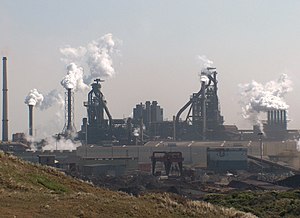Palomar, Maldoria
Palomar, Maldoria | |
|---|---|
| City of Palomar | |
 A Steel Mill in Palomar, 2020 | |
| Country | Shalum |
| Duchy | Maldoria |
| Government | |
| • Margrave | Kristian Schweiger |
| Area | |
| • City | 233.2 km2 (90.04 sq mi) |
| • Land | 231.3 km2 (89.31 sq mi) |
| • Water | 1.9 km2 (0.73 sq mi) |
| Elevation | 1,204 m (3,951 ft) |
| Population | |
| • City | 168,245 |
| • Metro | 376,528 |
Palomar is an industrial city located near the center of the Duchy of Maldoria. As of January 2020, its estimated metropolitan of 376,528 made it the second-largest in the Duchy after the capital city of Concordia. It was originally founded in 1814 under the supervision of House Schweiger, who had been issued a royal charter to develop the area and exploit the surrounding mountains which were resource rich. As the industrial revolution took hold across Shalum, the royal courts dispatched several experts from the Dresden area to create and oversee a planned development of the city in order to increase its manufacturing output. Due to the success of the initial program, it has served as a model for several other planned developments across the Empire.
The area surrounding the city represents the largest mineral deposits under Shalumite control, which had made it a subject of considerable development since the early stages of the Eracuran Great War. The Ashland-Manswell Rare Earth Industrial Complex is the biggest processing facility in the city with over 46 acres under roof between its various campuses and over 11,000 onsite employees. In recent years, environmental groups have raised concerns regarding the rapidly rising levels of pollution to the south of the city. Imperial health officials have also raised alarms due high levels of poor health and birth defects present in much of the city's population as a direct result of the current ecosystem.
History
While no records of the area prior to Shalumite colonization exist, oral traditions passed down by locals indicate that the region had been inhabited by several different tribes over the generations. While the mountainious region surrounding the Palomar area is rocky and barren due to a general lack of rain, the area around the city was fed by several streams created from the runoff of melting snow. Nomadic tribes would often lead their livestock through the area so that they could graze in nearby pastures, while those who settled in the area lived off the land. Cash crops that were traded with early explorers include tobacco and hemp which did not grow anywhere else in the area.